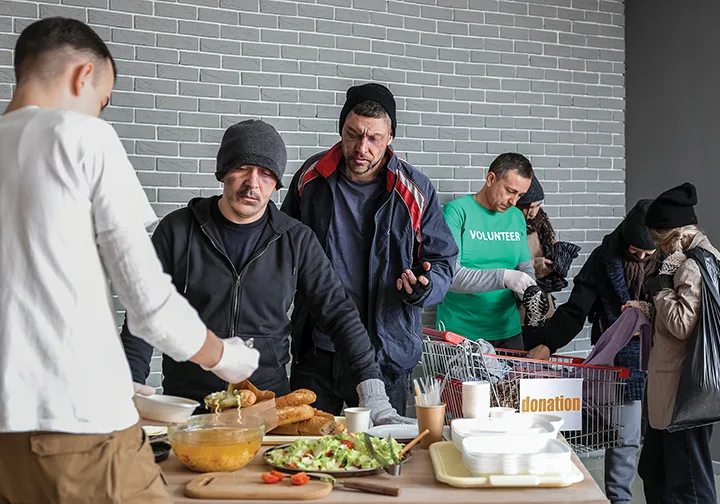
by Libby DuPont
Special to The Leaven
KANSAS CITY, Kan. — As a child, I have fond memories of Advent. I vividly remember lying under our Christmas tree, winding the music box on our Nativity set that played “Silent Night.”
I may not have understood the holiday as well as I do now, but I could grasp the joyful anticipation of the gift of a baby, which was mirrored in the preparations we did as a family: decorating the tree and house, making pierogi and cookies, wrapping gifts.
Lent, however, was a different story.
Every year I would dutifully “give up” something (usually chocolate) and put coins for the “missions” in a little cardboard milk carton I brought home from my Catholic school.
On Good Friday, I had a vague notion that I was supposed to feel sad, and perhaps a bit guilty. On Holy Saturday, the sadness was allowed to lift a bit as we colored eggs and took our food to church to be blessed.
On Easter Sunday, we were supposed to feel happy again, while we took pictures in our matching pastel outfits. The whole experience felt like an uncomfortable chore that was rewarded at the end with a chocolate bunny.

This changed for me in high school when I got involved in a youth program that my diocese sponsored over the Triduum. During the day on Holy Thursday, Good Friday and Holy Saturday, we would do service projects: visiting nursing homes, cleaning out homes, doing yardwork or sorting donations. In the evening, we would gather for the liturgy of the day.
This experience transformed my experience of Holy Week. The projects during the day allowed me to meet the suffering Jesus in the face of those experiencing poverty or loneliness, while building friendships with other teens who accepted me in a way I did not experience elsewhere. The liturgies emphasized that Jesus suffered, died and rose out of love for me.
As I reflect on that high school youth program, it strikes me that the reason it made such a difference in my faith was that for the first time, I saw the events of Holy Week in the context of relationships. While this naturally happened for our family at Christmas, the difficult realities of Lent and Holy Week made for a disjointed, out-of-context series of events. Since it wasn’t personal, I didn’t know what to make of it.

In their books and presentations, Catholic psychologist Dr. Greg Popcak and his wife Lisa often emphasize a point that reinforces my experience. They say that the best way to help our children become lifelong Catholics is to make faith the source of warmth in our homes.
In other words, we are most effective at passing on the faith when our religious practices are connected with close family bonds.
This makes so much sense when you consider that God is a Trinity. He is relationship, and he has given us the family throughout Scripture to help us understand him. Marriage is meant to be the witness of Christ’s love for his own bride, the church. Through the love of parents, children learn about the love of God the Father, and sibling relationships can teach us about the communion of saints.
Our faith is not simply a collection of doctrines or a moral code of behaviors. Our baptism is an adoption by God the Father into the family of the church, the smallest units of which are our own little domestic churches, our families.

So how do we connect the suffering and sacrifice of Lent to warm family relationships? I have a few suggestions.
First, we need to reframe our approach to prayer, fasting and almsgiving. They are not intended to be a white-knuckled attempt at depriving ourselves or a second chance at a failed new year resolution. Rather, they are an invitation into deeper relationship with Jesus.
Think of a couple in love. Don’t they love to spend time together? That’s prayer. Imagine all that a parent would sacrifice in order to comfort a critically ill child. That’s fasting. What kind of lavish attention and gifts do grandparents love to shower on their grandkids? That’s almsgiving.
How we spend our time, what we’re willing to sacrifice for and how generous we are with our treasures are all measures of who or what we love best. Lent is a time to reflect on Jesus’ great love for us and to return that love in a concrete way.
Secondly, we need to remember that we will come to love Jesus in a deeper way through our families, not despite them. Parents in the thick of raising kids might think longingly back to the days when they could sit for long, silent hours in front of the Blessed Sacrament at eucharistic adoration, or do arduous penances, as if those were the days when they could be close to God.
But family life is filled with its own rhythm of the sacred, if we have eyes to see it. In the sacrament of marriage, we have the opportunity to communicate with, sacrifice for and shower affection on Jesus — right in front of us in the person of our spouse!
If we are parents, we get the privilege of communicating — however imperfectly — the love of God the Father every time we cook a meal, dry a tear or offer a blessing. We need to be reminded that family life is a daily exercise of the corporal and spiritual works of mercy!
Finally, it’s important to remember that some of the closest bonds are formed in adversity. If your family struggles with difficulties and brokenness, welcome to the club! At Easter, Jesus turned the worst of humanity into a glorious victory, so Lent can be an opportunity to accept the challenges we cannot change.
Bringing Lent home
Here are some ways to connect Lent with the warmth of family relationships:
Prayer
• Read the daily Gospel as a family using School of Love’s (Schoolofloveusa.com) digital tools.
• Pray and discuss the rosary together using Holy Family School of Faith’s (Schooloffaith.com) rosary.
• Print off a psalm, Scripture passage or song you’d like to learn, and recite it after dinner or on the way to school.
• Ask extended family for prayer requests and pray for them throughout Lent.
• Follow an extra trip to church (daily Mass, eucharistic adoration, Stations of the Cross or even a pilgrimage) with a special family meal or small treat.
Fasting
• Set aside specific days for family meals — this may require the sacrifice of adjusted activities or mealtimes.
• Together fast from a favorite family food, or simplify family meals (such as having only soup, eating vegetarian or no eating out).
• Agree on specific days/times to be totally screen-free (parents, too!) and spend it doing something together: reading, taking a walk or playing a game.
• Fast from your own preferences for music, food or what activity to do in favor of those preferred by your spouse or kids.
• Fast from offering unsolicited advice or from insisting on things being done your own way.
Almsgiving
• Volunteer together at Catholic Charities, your parish or somewhere else.
• Spend time with aging relatives. If older parents live out of town, video chat with them or send notes in the mail.
• Seek healing for yourself. Our own wounds keep us from being the best gift to the people we love. Many groups exist in our archdiocese for specific types of situations, or you can find a Catholic counselor online at: archkck.org/catholic-counselors.
• Give the gift of forgiveness by asking and granting forgiveness within your family. Holding onto a hurt and need help to forgive? Check out the website at: forgivenessinstitutekc.com.






